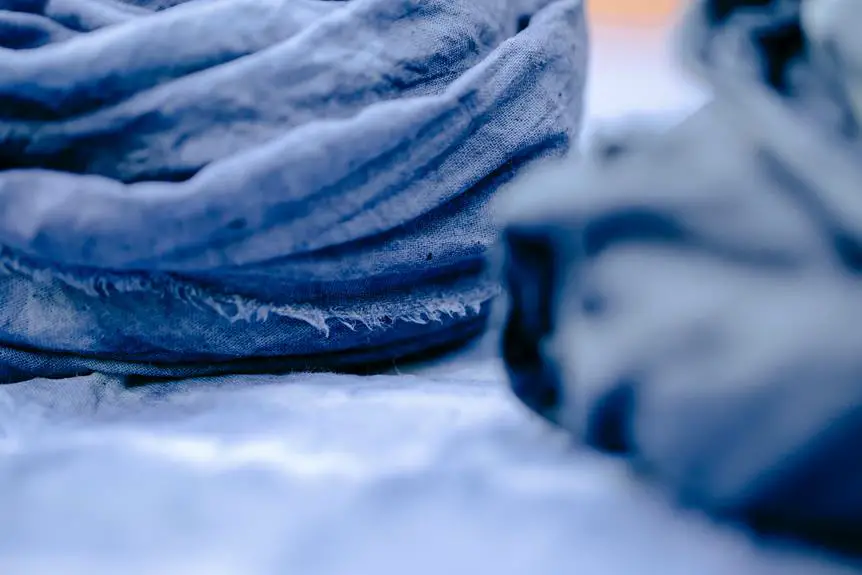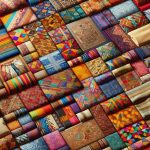Curious about the origins and techniques behind tie dye fabric? Wonder no more.
Tie dye fabric is not just a trendy fashion statement; it's a captivating art form with a rich history. This fabric, often associated with the hippie movement of the 1960s, involves a unique dyeing process that results in vibrant, swirling patterns.
From its cultural significance to its modern applications, tie dye fabric has evolved into a versatile and enduring style. Let's delve into the world of tie dye fabric, exploring its origins, techniques, and much more.
Key Takeaways
- Tie dye fabric originated in ancient cultures around the world, including Japan, India, and Africa.
- Tie dyeing involves tightly binding or folding fabric before applying dye, using techniques such as Shibori and Bandhani.
- Different tying techniques and dye application methods create various tie dye patterns, such as spiral, bullseye, crumple, and accordion folds.
- Tie dye is used in traditional clothing, accessories, and decorative items, and has cultural significance in various communities.
The Origins of Tie Dye Fabric
The origins of tie dye fabric can be traced back to ancient cultures around the world, where various techniques of resist dyeing were used to create vibrant and unique patterns.
History shows that tie dye has been practiced for centuries in places like Japan, India, and Africa, each with its own distinct methods and symbolism.
In Japan, shibori is a traditional tie dye technique that dates back to the 8th century, involving intricate folding, twisting, and binding of fabric before dyeing.
Meanwhile, in India, the art of bandhani involves tying small sections of fabric with thread before dyeing, creating intricate patterns symbolizing life's continuity and the cosmos.
African tie dye techniques often focus on using natural dyes and traditional symbols to convey specific meanings and stories within the fabric.
This rich history of tie dye techniques and symbolism has transcended time and continues to inspire modern-day artists and fashion designers to create contemporary pieces that pay homage to these ancient traditions.
The Art of Tie Dyeing
To achieve vibrant and intricate patterns on fabric, tie dyeing involves tightly binding or folding the material before applying dye. Tying techniques play a crucial role in determining the final design of the dyed fabric. Some common tying techniques include:
- Crunching: This technique involves scrunching the fabric into a tight ball and securing it with rubber bands or strings before applying dye. It creates a unique, random pattern on the fabric.
- Pleating: By folding the fabric into accordion-like pleats and then securing it with bands, you can achieve a symmetrical and repetitive pattern.
- Twisting: Twisting the fabric into a spiral or other shapes before securing it with bands results in bold, swirling designs.
After tying the fabric, the next step is dye application. Whether using traditional liquid dyes, spray dyes, or even natural dyes, how you apply the dye will greatly impact the final result. The way you saturate the fabric and the choice of colors will determine the intensity and blending of the hues in the finished design.
Mastering these techniques allows for the creation of stunning, one-of-a-kind tie dye pieces.
Tie Dye Techniques and Patterns
You can create a variety of tie dye patterns using different tying techniques and dye application methods. Traditional tie dye patterns include the classic spiral, bullseye, crumple, and accordion folds. To achieve these patterns, you'll need to master the art of folding, twisting, and tying the fabric to create the desired design. Each technique creates a distinct pattern when combined with various dye application methods.
When it comes to tie dye color combinations, the possibilities are endless. You can experiment with different color palettes to create vibrant and unique designs. Whether you prefer complementary colors for a harmonious look or contrasting colors for a bold statement, understanding color theory can help you achieve the desired effect. Additionally, the way you apply the dye can also influence the final result. From single-color applications to intricate multi-color designs, the way you layer and mix the dyes will impact the overall appearance of the tie dye pattern.
Mastering tie dye techniques and patterns involves practice and experimentation. By understanding the fundamentals and exploring different combinations, you can create stunning tie dye designs with confidence and creativity.
Cultural Significance of Tie Dye
Tie dye holds cultural significance for many communities, with each pattern and color combination carrying unique meanings and traditions.
- Symbolism: In various cultures, specific tie dye patterns and colors hold symbolic meanings. For instance, in some African communities, indigo tie dye represents spirituality and is often used in religious ceremonies.
- Cultural Practices: Tie dye is deeply intertwined with cultural practices around the world. It's used to create traditional clothing, accessories, and decorative items that are integral to ceremonies and everyday life.
- Artistic Expression: Many communities use tie dye as a form of artistic expression, reflecting their cultural heritage and values. The intricate patterns and vibrant hues often convey stories, myths, and folklore through the art of tie dye.
Tie dye isn't merely a fashionable trend but a significant aspect of cultural identity and heritage for many societies. Understanding the cultural practices and artistic expression behind tie dye provides insight into the rich tapestry of traditions woven into this vibrant fabric art.
Tie Dye in Fashion History
Tie dye has a rich history in fashion, dating back to ancient civilizations like the Egyptians and the Chinese.
The resurgence of tie dye in the 1960s and 1970s, during the counterculture movement, also played a significant role in shaping its influence on modern fashion.
Understanding the origins and the impact of this vibrant, colorful fabric in the fashion world can provide valuable insights into its enduring appeal.
Tie Dye Origins
Exploring the origins of tie dye in fashion history reveals a rich tapestry of cultural influence and artistic expression. Tie dye has ancient origins, with evidence of its practice dating back to the 6th century in countries like India and Japan. The traditional techniques of tie dye involve manipulating fabric to create intricate patterns before dyeing.
This art form was later embraced by the hippie counterculture of the 1960s, becoming synonymous with freedom and individuality in fashion. Tie dye's resurgence in contemporary fashion reflects a blending of its historical significance with modern design sensibilities.
The fusion of ancient techniques with current trends has elevated tie dye to a timeless and versatile fabric dyeing method, making it a staple in the fashion world.
Tie Dye Resurgence
With tie dye's resurgence in contemporary fashion, you can see how its historical significance has blended with modern design sensibilities, making it a staple in the fashion world.
Tie dye has made a significant comeback in modern fashion, with designers incorporating it into their collections in innovative ways. Its vibrant and eclectic patterns have been seen on runways and in the wardrobes of celebrities, contributing to its popularity in popular culture.
The resurgence of tie dye in fashion history showcases its ability to evolve and remain relevant, appealing to a new generation of fashion enthusiasts. This trend hasn't only revitalized tie dye's presence in the fashion industry but has also solidified its position as a timeless and versatile textile technique, proving that tie dye is more than just a passing fad.
Modern Applications of Tie Dye Fabric
You can find tie dye fabric being used in contemporary fashion, home décor, and accessories.
In interior design, tie dye is being incorporated into upholstery, curtains, and throw pillows to add a vibrant and eclectic touch to living spaces.
In modern art, tie dye fabric is being used as a medium for creating visually striking canvases, tapestries, and wall hangings, bringing a sense of fluidity and movement to artistic expressions.
Additionally, in fashion, designers are using tie dye fabric to create bold statement pieces such as dresses, shirts, and scarves, allowing individuals to express their unique style with eye-catching patterns and colors.
The modern applications of tie dye fabric extend beyond traditional uses, finding their way into various aspects of contemporary living.
Whether it's adding a pop of color to your living room with tie dye curtains, showcasing a mesmerizing tie dye tapestry as a centerpiece in your art collection, or making a fashion statement with a tie dye ensemble, the versatility and visual appeal of tie dye fabric continue to captivate and inspire.
Tips for Caring for Tie Dye Garments
To maintain the vibrancy of your tie dye garments, follow the care instructions provided on the label.
Proper garment maintenance is crucial for preserving the rich colors of tie dye. When washing tie dye garments, turn them inside out to protect the vibrant colors from fading. Use cold water and a gentle detergent to prevent bleeding and maintain the intensity of the dyes.
It's essential to wash tie dye items separately to avoid color transfer onto other clothing. Additionally, consider hand washing your tie dye garments to ensure the longevity of the colors.
When drying, avoid direct sunlight as it can cause the dyes to fade. Instead, dry your tie dye clothing in the shade or indoors. If using a dryer, opt for a low-heat setting.
Iron the garments inside out or with a cloth over the design to prevent direct contact with the iron.
Following these color preservation tips will help to keep your tie dye garments looking vibrant and fresh for a long time.
Frequently Asked Questions
Can Tie Dye Fabric Be Used for Home Décor and Accessories?
Yes, tie dye fabric can be used to add vibrant and unique elements to your home décor and accessories. Using tie dye fabric for home décor can infuse a bohemian or eclectic feel, while tie dye fabric for accessories can add a pop of color to your wardrobe.
What Are Some Unique Tie Dye Patterns and Techniques That Are Not Commonly Known?
To create unique tie dye patterns, experiment with innovative techniques like ice dyeing, shibori, and reverse dyeing. Embrace unconventional designs by exploring resist methods and using unexpected materials. These experimental dyeing methods yield extraordinary results.
Is Tie Dye Fabric Suitable for All Types of Clothing, or Are There Specific Materials That Work Best?
For different fabric types, consider the suitability and dyeing techniques. Cotton works best due to its absorbency, but blends can also be dyed with proper techniques. Prepping the fabric and using the right dye are essential for successful tie-dyeing.
Are There Any Health or Environmental Concerns Related to Tie Dyeing and Wearing Tie Dye Garments?
When tie dyeing, environmental impact can result from chemical dyes and their disposal. Health risks include potential skin irritation from dyes. Consider natural dyes and proper disposal methods to minimize these concerns.
What Are Some Creative Ways to Incorporate Tie Dye Fabric Into DIY Projects and Crafts?
When looking for creative crafts, consider using tie dye fabric in DIY projects. It's a versatile material that can be used to make unique clothing, accessories, or home decor. Experiment with different folding and dyeing techniques for stunning results.
- How Does Ring Spun Cotton Affect Garment Fit and Shape Retention? - August 13, 2024
- What Are the Challenges in Producing Ring Spun Cotton? - August 13, 2024
- Is Ring Spun Cotton Suitable for Plus-Size Clothing? - August 13, 2024




